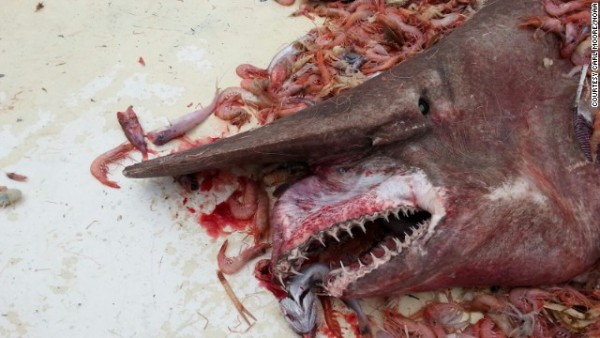Rare Goblin Shark Caught: May Be The Ugliest One Yet
| Robert Sarkanen | | May 06, 2014 08:31 AM EDT |
(Photo : Carl Moore) Close view of the Goblin Shark caught by Carl Moore on April 19, 2014.
(Photo : Carl Moore) Full body view of the Goblin Shark caught by Carl Moore on April 19, 2014.
Outside the Gulf of Mexico, shrimp fisherman Carl Moore, 63, of Townsend, Georgia hauled up this unlikely wonder of nature, only the second of its species to be spotted in the area, on April 19.
What was Moore's first comment at the time of the catch? "Man, he's ugly!"
Like Us on Facebook
Moore had been half-way through an 18-day fishing trip when he caught the strange beast, his first in 50 years of shrimping in the Atlantic and the Gulf.
Though he reportedly caught all kinds of strange sea creatures before, the unique catch in the midst of a trawling net full of red shrimp left him in "disbelief".
Moore proceeded to take photos of the strange creature prior to releasing it back into the ocean as per his usual practice of releasing anything that's alive.
Moore started carrying a camera with him on his fishing expeditions on account of his soon to be four year-old grandson was eager to see pictures of his grandfather's journeys. Safe to say, the boy will definitely be satisfied with these.
Moore estimated the beast at between 18 and 20 feet in length, though marine biologist and shark expert, John Carlson, guessed it being a "mere" 15 feet.
Nevertheless, Carlson deems it an important find, as the goblin shark are seldom seen aside from the Pacific coast of Japan, where the majority of sightings have been recorded.
Not much is known of the goblin shark, neither maximum life expectancy or growth period have been documented, but at its ample size the goblin shark is certain to have few natural predators, according to Carlson.
The goblin shark is believed to be the only extant of its family of species, a line dating back roughly 125 million years and it lives primarily at a depth of up to 4,000 feet, a depth where sunlight no longer reaches.
The goblin shark relies instead on other senses than sight to track its prey, which consists mainly of crabs, deep sea fishes and shrimp. Its distinctive teeth function as a grasping claw once the shark has captured its intended victim, the long needle-like fangs meant to pierce and crack through crab shells with ease.
TagsRare, Goblin Shark, Fishing, Prehistoric, Carl Moore, Shrimping
©2015 Chinatopix All rights reserved. Do not reproduce without permission
EDITOR'S PICKS
-

Did the Trump administration just announce plans for a trade war with ‘hostile’ China and Russia?
-

US Senate passes Taiwan travel bill slammed by China
-

As Yan Sihong’s family grieves, here are other Chinese students who went missing abroad. Some have never been found
-

Beijing blasts Western critics who ‘smear China’ with the term sharp power
-

China Envoy Seeks to Defuse Tensions With U.S. as a Trade War Brews
-

Singapore's Deputy PM Provides Bitcoin Vote of Confidence Amid China's Blanket Bans
-

China warns investors over risks in overseas virtual currency trading
-

Chinese government most trustworthy: survey
-

Kashima Antlers On Course For Back-To-Back Titles
MOST POPULAR
LATEST NEWS
Zhou Yongkang: China's Former Security Chief Sentenced to Life in Prison

China's former Chief of the Ministry of Public Security, Zhou Yongkang, has been given a life sentence after he was found guilty of abusing his office, bribery and deliberately ... Full Article
TRENDING STORY

China Pork Prices Expected to Stabilize As The Supplies Recover

Elephone P9000 Smartphone is now on Sale on Amazon India

There's a Big Chance Cliffhangers Won't Still Be Resolved When Grey's Anatomy Season 13 Returns

Supreme Court Ruled on Samsung vs Apple Dispute for Patent Infringement

Microsoft Surface Pro 5 Rumors and Release Date: What is the Latest?











